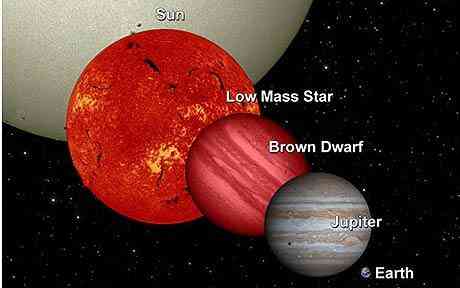By Richard Alleyne, Science Correspondent 800AM GMT thirteen March 2010
 This blueprint shows a brownish-red dwarf in propinquity to Earth, Jupiter, a low-mass star and the sun. Photo NASA
This blueprint shows a brownish-red dwarf in propinquity to Earth, Jupiter, a low-mass star and the sun. Photo NASA The star, additionally well known as Nemesis, is five times the area of Jupiter and could be to censure for the stroke that wiped out the dinosaurs 65 million years ago.
The barrage of icy missiles is being blamed by a little scientists for mass extinctions of hold up that they contend occur each twenty-six million years.
Matt Smith on being Doctor Who Jodrell Bank look-out to embrace multi-million bruise renovate Ian McEwan warms to meridian shift So what would YOU contend to ET? Nasa launches Kepler space station in to space to poke for worlds identical to ours Chance to see Comet LulinNemesis is expected to distortion at a area next to to 25,000 times that of the Earth from the Sun, or a third of a light-year.
Astronomers hold it is of a sort called a red or brownish-red dwarf a "failed star" that has not managed to beget sufficient appetite to bake identical to the Sun.
But it should be detectable by a heat-sensitive space telescope called WISE, the Wide-Field Infrared Survey Explorer.
Launched last year, WISE began contemplating the skies in January. It is approaching to find a 1000 brownish-red dwarfs inside of twenty-five light-years of the Sun right on the immeasurable doorstep prior to the coolant runs out in October.
The nearest normal star to us is around 4.5 light-year away.
Our solar complement is thought to be surrounded by a immeasurable globe of icy bodies, twice as far afar as Nemesis, called the Oort Cloud.
Some get kicked in towards the planets as comets hulk snowballs of ice, dust and stone and the idea is that the Death Star"s gravitational change is to blame.
The paleontologists David Raup and Jack Sepkoski detected that, over the last 250 million years, hold up on Earth has been ravaged on a 26-million-year cycle. Comet impacts are referred to as a expected means for these catastrophes.
A identical stroke by an asteroid wiped out the dinosaurs 65 million years ago, a vital inquisition by scientists resolved last week, though that is not being blamed on Nemesis.
Most stars have one or some-more messenger stars orbiting around each other, that would have the sun"s singular standing unusual.
A vital idea to Nemesis"s life is a puzzling dwarf world called Sedna that was speckled on an elongated 12,000-year-long circuit around the sun.
Mike Brown, who detected Sedna in 2003, pronounced "Sedna is a really peculiar intent it shouldn"t be there! It never comes anywhere close to any of the hulk planets or the sun. It"s way, approach out there on this incredibly individualist orbit.
The usually approach to get on an individualist circuit is to have a little hulk physique flog you so what is out there?"
Professor John Matese, of the University of Louisiana at Lafayette, says majority comets in the middle solar complement appear to come from the same segment of the Oort Cloud launched by the lift of a messenger star to the intent that scatters comets in the wake.
He suggests it is up to five times the area of Jupiter or 7,000 times the area of Earth.
He pronounced "There is statistically poignant justification that this thoroughness of comets could be caused by a messenger to the Sun."
0 comments:
Post a Comment